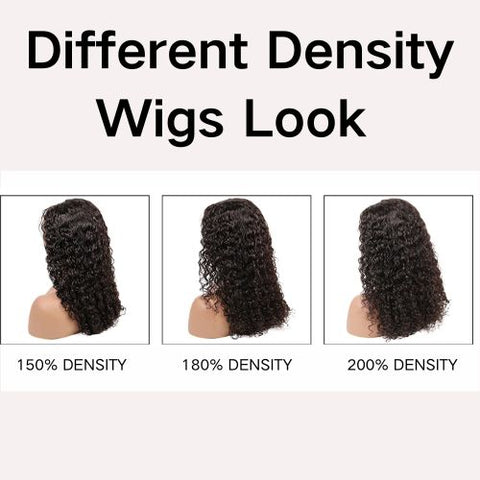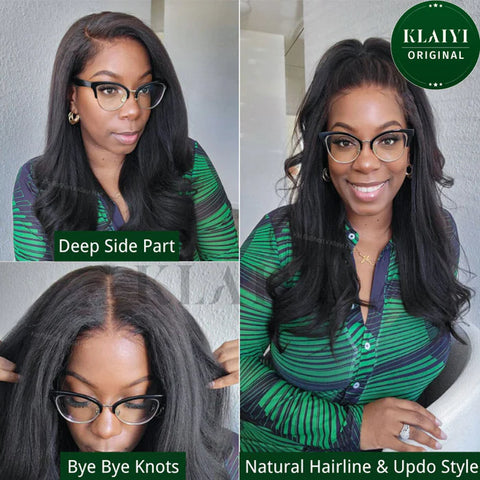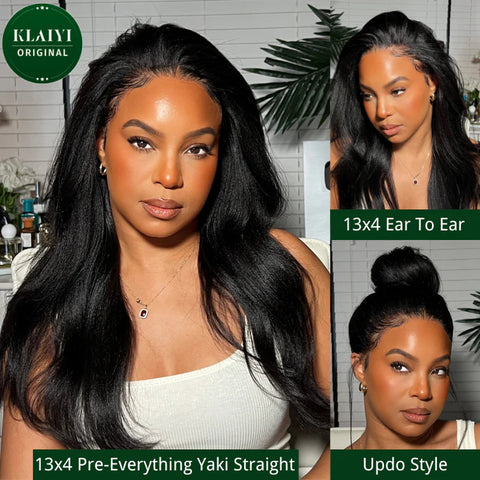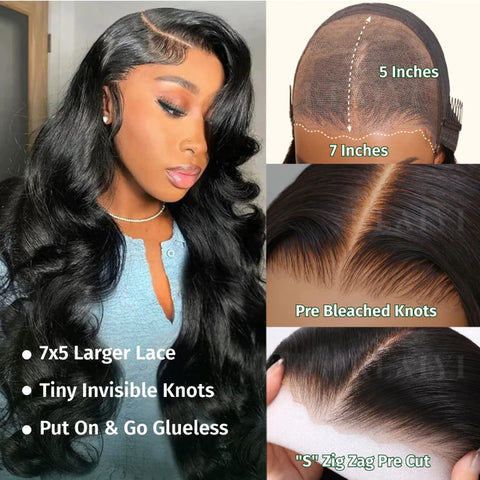Join The Forum To Get inspired Ideas
What Is The Difference Between 150%,180%,200% and 250% Density Wigs?
Wigs have become tremendously popular these days, especially among African-American or African women. When it comes to buying a wig, one of the most important things you need to put into consideration is its density. You need to know beforehand the density of wig that suits your taste and preference, as well as your lifestyle.
In this article, we are going to understand what a wig density is, 150% density meaning, 180% density meaning,200 density,250 density and explain the differences between these popular wig densities. Let’s get started!
1. What Is A Wig Density?
In the context of wigs, "density" refers to the thickness or amount of hair on a wig cap. It is measured as a percentage and indicates the volume of hair in the wig. Different density percentages are available for wigs, including 130%, 150%, 180%, 200%, and 250%.
A higher density percentage results in a thicker and fuller wig, while a lower density percentage creates a more natural and lighter appearance.
2.The Common Density Features To Know
Common density percentages for wigs include:
130%: light density
Which is a lower density where the wig appears more natural and lighter. It is suitable for those who prefer a delicate, less bulky look.
150%: medium density
Which is a medium density that provides a balance between a natural look and added fullness. It is a popular choice with a versatile and realistic look.
180%: High Density
Which is a higher density that creates a thicker, fuller wig. It gives a more dramatic and voluminous look and is often chosen for glamorous or bold looks.
200%: super high density
Full and voluminous. They are perfect for longer styles and looks, but can still be used for coiffures and shorter styles.
250%: the highest density
These are the fullest, most luxurious wigs on the market. They are perfect for big, celebrity style looks.
3.What is a low density wig?
We all know that there are many kinds of density of wigs on the market, ranging from 120%-250%.But how to distinguish between high and low density? Generally, wigs with density below 120% is called low-density wig while density above 150% is called high-density wig.
A wig with a density of 120% or 130% is called average density or natural density. But everyone has different preferences for the density of wig, so their views on density may also be different. For those who like dense hair, 130% density can also be a bit thin.
4.Low Density VS High Density, Which to Choose?
If you don’t know which one to choose, let’s find out what differences lie between low density vs high density wigs.
Overlook. The difference in overlook is the most obvious. A high-density wig will look thick and full, while a low-density headgear will have a natural or thin look.
Breathability. The higher the density of the wig is, the more hair is tied into it, so high-density wigs are often not as breathable as low-density wigs.
Price. Price is also a relatively obvious difference between the two. The higher the density of the wig, the more expensive it will be.
Weight. Wigs with different densities will also have a big difference in weight. For example, a 150% density 20 inch human hair wig is about 220g while 200% hair is 255g with the same length.
5.Who suit for low density wigs?
Girls with low budget. As what we have mentioned above, the high-density wig will be more expensive than low density hair, so you can choose the low density human hair wigs if you want to try a new wig but don’t have enough budget.
Girls with very thick natural hair. Why do I advice people with very thick natural hair to try low density wig? If your natural hair is very full and you wear a very heavy wig, your scalp will be very hot and humid.
People don’t like heavy hair. If you want lightweight wig, low density lace front wigs will be your top choice. Because it’s easy to style and lightweight.
Girls with thin natural hair. For girls who are suffering hair loss problem or natural hair is very thin, I recommend to try low density wig with human hair. It can not create a very thick look, but the hair volume is still more than the natural hair and it looks more realistic.
6.Factors Influencing Wig Density
Several factors contribute to determining the density of a wig:
1. Personal Preference: The desired density of a wig varies from person to person, depending on their individual style preferences and the desired look they wish to achieve. Some may prefer a natural and lightweight look with lower density, while others may opt for a fuller and voluminous appearance with higher density.
2. Hair Texture: The natural texture of the wig's hair also affects its perceived density. Straight hair appears denser than wavy or curly hair due to its sleek and compact nature. Curly or wavy hair tends to have more volume and may require a lower density to avoid an overly bulky look.
3. Hair Length: The length of the wig affects the perception of its density. Longer wigs typically require higher density to maintain a fuller appearance, while shorter wigs can be styled with lower density for a more natural and lightweight feel.
7. How To Choose the Right Wig Density
Selecting the appropriate wig density is crucial to achieving a seamless and natural look. Consider the following factors when choosing wig density:
1. Face Shape: Different face shapes can benefit from specific wig densities. For example, individuals with round faces may prefer higher density wigs to add volume and create the illusion of a more elongated face shape. Those with angular faces may opt for lower density wigs to soften their features.
2. Desired Hairstyle: The hairstyle you intend to achieve also influences the ideal density. If you plan to wear the wig in an updo or sleek style, lower density may suffice. However, for voluminous styles or hairstyles that require extra thickness, higher density is recommended.
3. Occasion and Personal Style: Consider the context in which you plan to wear the wig. For everyday use, a medium density wig provides a versatile and natural look. Special occasions or theatrical performances may call for higher density wigs to create a statement or capture attention.
8 130% vs 150% vs 180% vs 200% vs 250%, Which Is good for A Wig?
130% density is considered light density for wigs, and it's a popular and versatile option. Here are some considerations for 130% density wigs:
130% density wigs offer a more natural, lightweight look. It mimics the density of natural hair for those who prefer a subtle and less dense look. Light density wigs are often chosen for everyday wear as they offer a more understated and casual style. They are suitable for extended use.
150% density is considered a medium density for wigs and is a popular choice for many. This density provides a balanced look that is neither too light nor too heavy, offering a natural look and moderate fullness. If you're looking for a natural and versatile option, 150% density wigs are a good choice for many people.
180% density is considered high density for wigs, and depending on your preferences and the look you want to achieve, it may be a good option.
Higher density wigs are often chosen for more dramatic styles, such as long curls or elaborate updos. The extra volume can create dramatic hairstyles.
When choosing a high density wig, it's important to consider your comfort level. Some people find that higher density wigs are heavier, so if comfort is a priority, you may want to evaluate how it feels to wear a wig of this density. If you prefer a full, voluminous hairstyle, a 180% density wig may work well for you.
200% density is considered very high for wigs. It delivers an extremely full and voluminous look, providing a dramatic and glamorous appearance.
Here are some things to keep in mind: 200% density wigs will give you a bold and dramatic hairstyle. If you like big volume and want to make a strong visual impact, then this density may be a good choice.
Ultimately, the choice of density depends on your personal taste. If you like the drama of a thicker hairstyle, then 200% density may be the right choice for you.
For wigs, 250% density is considered extremely high. It is exceptionally thick and presents a very bold and dramatic look. Here are some considerations:
A wig with a density of 250% will provide significant volume for those who prefer bold and personalized hairstyles. This density is often used for sophisticated and luxurious hairstyles, as the extra thickness allows for a creative and dramatic look. If you prefer a very full and voluminous look and want to create a strong visual effect.
9.Where To Buy A Prefect Density Wig?
Final thoughts
In conclusion, the choice between different wig densities, whether it's 150%, 180%, 200%, 250%, or any other percentage, depends on individual preferences, styling goals, and comfort considerations. To pick the right one, you need to determine the weight you can handle, your lifestyle, and your budget. These are crucial factors that can help you choose the right wig density for you.






















